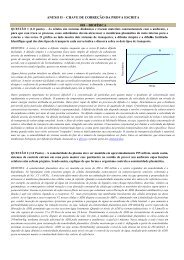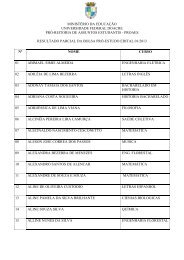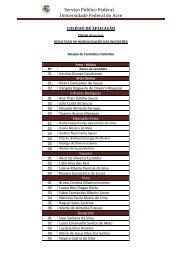Revista Brasileira de Ornitologia - Universidade Federal do Acre
Revista Brasileira de Ornitologia - Universidade Federal do Acre
Revista Brasileira de Ornitologia - Universidade Federal do Acre
Create successful ePaper yourself
Turn your PDF publications into a flip-book with our unique Google optimized e-Paper software.
<strong>Revista</strong> <strong>Brasileira</strong> <strong>de</strong> <strong>Ornitologia</strong>, 20(4), 443-446Dezembro <strong>de</strong> 2012 / December 2012artigo/ARTICLEFirst record of Augastes scutatus for Bahia refines thelocation of a purported barrier promoting speciationin the Espinhaço Range, BrazilMarcelo Ferreira <strong>de</strong> Vasconcelos 1,3 , An<strong>de</strong>rson Vieira Chaves 2 and Fabrício Rodrigues <strong>do</strong>s Santos 21Pontifícia Universida<strong>de</strong> Católica <strong>de</strong> Minas Gerais. Pós-graduação em Zoologia <strong>de</strong> Vertebra<strong>do</strong>s and Museu <strong>de</strong> Ciências Naturais. Avenida Dom JoséGaspar, 500, Prédio 41, Coração Eucarístico, CEP 30535-610, Belo Horizonte, MG, Brasil.2Universida<strong>de</strong> Fe<strong>de</strong>ral <strong>de</strong> Minas Gerais. Departamento <strong>de</strong> Biologia Geral, Instituto <strong>de</strong> Ciências Biológicas. Caixa Postal 486, CEP 31270-901, BeloHorizonte, MG, Brasil.3Corresponding author: mfvasconcelos@gmail.com.Received on 13 October 2011. Accepted on 19 August 2012.ABSTRACT: First record of Augastes scutatus for Bahia refines the location of a purported barrier promoting speciation in theEspinhaço Range, Brazil. We present the first records of Augastes scutatus for the state of Bahia, whose range now is only 150 kmaway from that of its purported allospecies (A. lumachella). Based on geological evi<strong>de</strong>nce and vegetation cover, we suggest that thepossible vicariant barrier that led to the speciation of these allospecies would be represented by the Caetité plateau (covered mainlyby Cerra<strong>do</strong>) and the lowland areas of the Contas river valley (covered mainly by Caatinga), both in southern Bahia. Possibly, theisolation of those two species in different sectors of the Espinhaço Range (northern and southern parts) is related to climatic changesof the Plio-Pleistocene, which should led populations of an ancestral lineage to take refuge in these higher areas during one or moreinterglacial periods.KEY-WORDS: Augastes; biogeography; campos rupestres; geographical barrier; vicariance.INTRODUCTIONThe genus Augastes Gould, 1849 is represented bythree species: A. scutatus (Temminck, 1824), A. lumachella(Lesson, 1838) and A. geoffroyi (Bourcier, 1843)(Schuchmann 1999). Augastes scutatus and A. lumachellaare consi<strong>de</strong>red possible allospecies, both restricted to thecampos rupestres vegetation in the highlands of the EspinhaçoRange, eastern Brazil (Silva 1995, Sick 1997, Vasconcelos2008). Augastes scutatus is known to be restricted to thecentral and southern portions of the Espinhaço Range (inMinas Gerais state), while A. lumachella is distributed inthe northern section of this mountain range (ChapadaDiamantina region and northern mountains in Bahiastate; Ruschi 1962, 1963, Grantsau 1967, 1988, Silva1995, Sick 1997, Schuchmann 1999, Vasconcelos 2008,Souza et al. 2009). Both species of Augastes en<strong>de</strong>mic to theEspinhaço Range are tightly linked to the campos rupestresflora (see Vasconcelos 2011), feeding on nectar and usingmaterial to build nests from various plant species en<strong>de</strong>micor typical of this vegetation type (Ruschi 1962, Grantsau1967, 1988, Vasconcelos & Lombardi 2001, Vasconceloset al. 2001, Macha<strong>do</strong> et al. 2003, 2007, Rodrigues 2011).Augastes geoffroyi ranges in the An<strong>de</strong>an region, fromBolivia to Colombia and Venezuela (Ruschi 1963, Fjeldså& Krabbe 1990, Schuchmann 1999). Nevertheless, thereare <strong>do</strong>ubts whether this species should be consi<strong>de</strong>red arepresentant of the genus Augastes or the genus Schistes(Schuchmann 1999), thus its evolutionary affinities stillneeds to be better studied un<strong>de</strong>r a phylogenetic perspective(see Abreu 2006).The mountains of the Espinhaço Range consistof an ancient unit belonging to the pre<strong>do</strong>minantlyquartzitic Espinhaço Supergroup, which was <strong>de</strong>positedin a continental rift (starting around 1,752 millionyears ago) and later metamorphosed and uplifted in theBrasiliano orogeny, between 650 and 550 million yearsago (Schobbenhaus 1996, Barbosa et al. 2003, Pedreira &De Waele 2008). With the tectonic events that resulted inthe fragmentation of Gondwanaland in the Mesozoic, theregion suffered differential movement and sag, with upliftof neighboring blocks. This movement was continued,but with less intensity, throughout the Cenozoic (Saadi1993, 1995, Uhlein et al. 1995, Horn et al. 1996, Potter1997, Ab’Sáber 2000, Cruz & Alkmim 2007, Knauer2007, Caxito et al. 2008).Consi<strong>de</strong>ring both putative allospecies in easternBrazilian mountains (A. scutatus and A. lumachella), Silva










